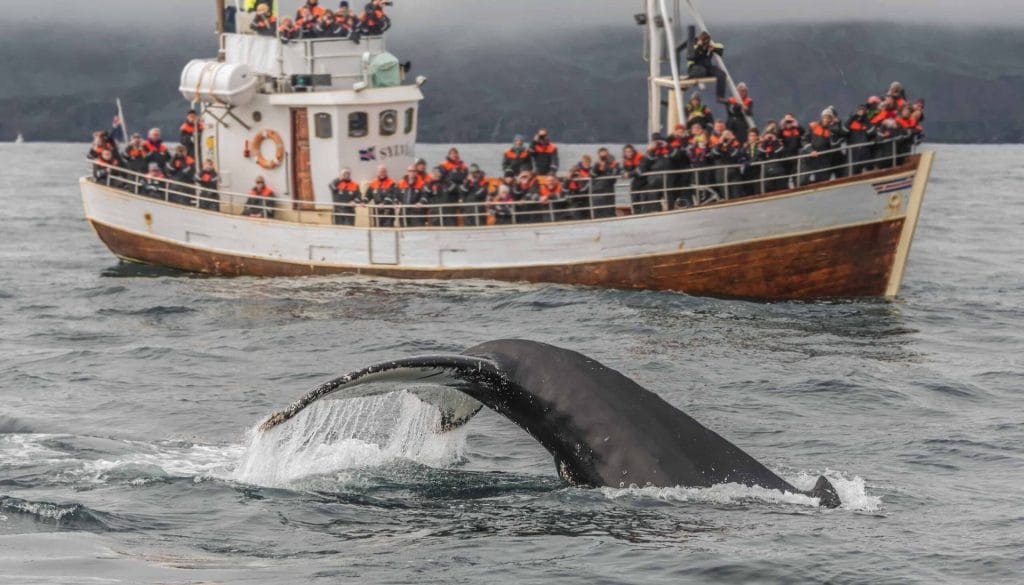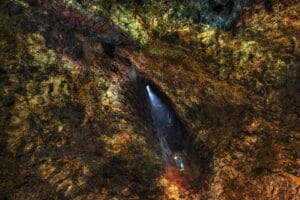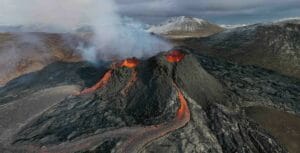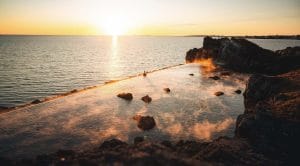Summer season holds a lot more than just incredible festivals, the glorious midnight sun, and thrilling hikes. Whales normally do not reside in Iceland but they migrate from their breeding grounds in the south to the shores of Iceland in the north for feeding. The warm water brought in by the gulf streams mixes with the cold water of the Atlantic Ocean and create a soothing mixture for the visiting fishes. Back in the days, whale hunting was a very popular industry and Icelanders were known to go whaling on a very large scale. Now, whales and other migrating species of fishes are a huge part of Iceland’s tourism industry. Whales stay in Icelandic waters all year, but April to October is the best season to see the whales. You can pretty much catch a glimpse in spring, summer as well as at the starting of the winter season.

What to pack for the tour?
Summer or winters, the weather near the shore or deep into the water is often cold. So, make sure that you are dressed properly for the occasion. Layering up well with warm clothes is a good idea. You can always layer down if you start to feel a bit hot but you won’t be able to escape from the cold if you do not bring a warm jacket, to begin with. Also, you would not want to run to a warm corner every 10 minutes and miss the sighting of a whale. So, layer up because it’s better to be safe than sorry. You will usually get a warm suit when joining the whale watching tours, so you do not need to bring that on the tour.
Since the tours mostly last just a couple of hours, you do not need to bring lunch but you can pack a few snacks since most tours do not provide meals.
Spot the Species – Whales in Iceland
Having a basic knowledge of the kinds and types of whales that you can see in Iceland will not only help you choose between many tours available in the country, but also prove fruitful while identifying the kind of whale spotted when you are on a tour. Different parts of the country offer a different kind of vibe and specialty to the tourists so you need to sort your priorities before you make a choice and select a whale watching tour. Following are general as well as eccentric fun facts about Iceland’s most common whale species.

Minke Whales
Minke whales are the most common great whales found in Iceland. The good thing about mink whales is that they stay near the shores of the island for the longest amount of time which means that even though feeding season ends in September, there is still a chance for you to see them in the winter season. Mink Whales tend to be smaller as compared to other species of whales and they are also the 2nd smallest kind of Baleen whales. They have a length of about 9 meters in total. They can be easily distinguished from other fishes by their beautiful shades of Black, Grey, and Purple. Minke whales are generally very shy. Although due to their numbers and the habit of breathing three to five times before a deep dive, one has bountiful chances of spotting them while on a trip. The primary diet of minke whales now includes krill after the collapse of the capelin stock in the north Atlantic Ocean.
The whale watching industry in Iceland predominantly resides on minke whale which makes the greatest number of appearances out the water. You will not see them jumping high in the air like other species though. Minke whales bring out about 40% of their bodies in the air when surfacing and do not raise their flukes while diving back in the water which is very peculiar for whales.
Humpback Whales

Almost every single excursion in Icelandic waters is guaranteed to have at least 1 humpback whale sighting. They are extremely active, acrobatic, and loves to be seen and noticed. Humpback whales also belong to the same family a that of the Minke, Blue, and Fin whales, the Balaenopteridae family. They can be spotted jumping around in the water and can be easily identified with their ‘hump’, black dorsal coloring, long white tail with black colored patterns on, and lengthened pectoral fins. Humpback whales are huge. The males are generally 13-14 meters big while females are about 15-16 meters in size. The largest humpback whales recorded till now was 19 meters in size and had 6-meter-long pectoral fins each.
While whales usually keep their distance from the boats and kayakers in the waters, humpbacks are known to be extra carefree and naughty. There is a good chance that you will get a first seat show of a humpback whale breaching out of the water flaunting its magnificent tail.
Fun fact about humpbacks, each humpback whale can be distinguished based on the pattern they feature on their tails. Each humpback whale has a unique pattern of black color on the side-lines of their tails which makes them unique. Now, you will know for sure if you got to see the same one multiple time or a bunch of different ones!

Orcas
The largest member from the family of oceanic dolphins, Orca, or killer whales is one of the most common whales found on and around the shores of Iceland. About 5000 Orcas are living in and around Iceland. Orcas can be distinguished into three categories: resident, transient, and offshore. Most orcas found in Iceland are transient. They travel frequently from one place to another and move in small groups. Transient orcas primarily feed on shore mammals like seals but also have minke whales as a part of their diet.
It is guaranteed that if an Orca whale happens to cross your paths, you will not miss it. The features are so distinguished due to their black and white monochromatic appearance. Orcas have a big white patch around their eyes and have a jet-black chest, sides, and back. the bottom part is mostly white with a few black patches. Some types of orcas can have shades of grey instead of black. Some killer whales in the North Atlantic Ocean are even found to be completely white – incredibly rare but true.
Orcas are very social and engage in a regular session of breaching (jumping out of the water completely) and tail flapping. The ideal place to catch a glimpse of these monochromatic beauties is the Snaefellsnes peninsula in the west of the country, east Fjords, and the south coast.
White-Beaked Dolphins
A robust species, white-beaked dolphins are one of the commonly spotted dolphins around Iceland. They stay relatively close to the shores throughout the year and hence can be seen even in the offseason when migrating animals have returned south. A fully grown white-beaked dolphins are about 2.3 to 3.1 meters big which is almost 7 to 10 ft tall. Their upper body is dark grey colored with few lighter grey patches. Although the name implies that the beak is white, it may vary in some fully grown adults and come out as light grey, ash grey or even dark grey. North Atlantic and the western Atlantic are densely populated with white-beaked dolphins which is why they are a common sight in Iceland as well.
Pilot Whales

You take one look at them and you will be moved by the innocent look that they have on. Pilot whales are large, sleek dolphins often spotted in Iceland. There are approximately 35,000 pilot whales estimated to be in or around Iceland. Pilot whales are mostly dark brown, grey, or black with a few white or grey patches behind the dorsal fin along with an anchor-shaped greyish-white patch under the skin. Pilot whales are very transient but stay offshore mostly. Even then it is incredibly rare to spot one due to their general aversion to boats like beaked whales. Pilot whales are generally divided into two groups, long-finned and short-finned. Long-finned whales prefer colder water and hence find habitat in North Atlantic Ocean. Squid is their primary diet and they do not have much predator attention or human whaling threats.
Harbor Porpoises
One of the six species in the porpoise’s family, harbor porpoises is one of the smallest marine mammals. As evident by the name, harbor porpoises stay close to the shore and are spotted around the country all year round. Harbor porpoises are very shy and small in size. They rarely ever surface and when they do, it is just for a moment. You will need an experienced tour guide to spot them from a distance or from near either. Harbor porpoises are relatively sedentary and do not move a lot. The movement is often seen as moving from onshore to offshore. Very unsocial, these fishes when moving in a group, do not take more than five to six members. Hunting and fishing are done groups by harbor porpoises which could be the ideal time to catch a sight.

Beaked Whales
Out of 22 species of beaked whales, only 3 or 4 are well known by humans which makes them one of the rarest marine mammals. The shy and less abundance of these whales results in very occasional sightings. Beaked whales are also a part of the toothed whale group sharing the space with much larger companions such as sperm whales. The size of these fishes can range anywhere from 4 to 13 meters. The physical characteristics that distinguish beaked whales in the presence of a beak (much like that of dolphins) and a very clear absence of the notch in their tails. Very dep divers, beaked whales take dives which are over 500-meter deep at most times. Beaked whales are famously known for their unique surfacing move, the spy-hopping in which they pop their head out of the water just a little as if spying on something.

Whale Watching in Summers
One of the top activities loved by the tourists, whale watching is every bit appealing given the milder weather, cold but soothing winds, the blazing sun, and the bright long days. Most tours in Iceland, weather hiking, driving, or snowmobiling, are dependent on the weather conditions. Since summers are much calmer than all other seasons in the country, it is almost guaranteed that you will spot a few jumping beauties in the water within the waves. The best part is that most whale watching tours let you use your ticket for the next ride if you do not get to see whales on the ride it was bought for. Even though summers are supposed to be calm and mild, you still need ample layers of warm clothes for a comfortable ride. The summer season brings great chances for you to spot species like Mink, Humpbacks, Blue Whales, Fin Whales, basking sharks (world’s second-largest species of fishes), and white-beaked dolphins as well. You do not have to go deep into the water to spot one of these species.
You have a decent chance of catching sperms whales as well even though they prefer deeper waters. Sperm whales can be spotted in Breiðafjörður Bay where they can hunt. Although bottlenose whales sometimes swim to the shallow waters while hunting and are visible from tour boats easily. Reykjavík, Akureyri in the north, Húsavík and the Snæfellsnes Peninsula are some of the best places for whale watching in Iceland.

Whale Watching in Winters
Summer gets most of the animal lovers crowd – that’s true but if you want to have your own space and would like to enjoy your gracious animals on your own taking your sweet time, then winters are your ideal season for whale watching. People who are not very comfortable with extremely cold temperatures steer clear of the winters as the season is not only gut-freezing cold but also bring very crisp and cold winds. But the lesser number of tourists on board will mean that you won’t have to jump around to catch a sight of a breaching humpback or tail flapping sperm whale.
The most common whales seen in winters are actually from some of the rarest species, white-beaked dolphins and harbor porpoises. Both these species are rather shy and steer clear of human contact and company. The lesser boats on the water in winter encourages these extremely deep divers to surface around and breach every once in a while. Breiðafjörður Fjord is a wintering ground for herrings which makes it perfect for predators like Orcas and other great whales including minke and humpbacks.

Top Places to Go Whale Watching
The Capital City – Reykjavík
For tourists who are staying in the capital city, joining a tour from Reykjavík is the most convenient way to get the whale watching sites. Most meeting spots for tours are within walking distance from the hotels so transportation is not going to be a likely issue. Most whale watching tours go to Faxaflói Bay which is a reliable place to spot white-beaked dolphins along with harbor porpoises and minkes. The sighting happens almost all-year-round. But if by chance, you are not able to spot a whale on your tour, agencies let you join the next one free off cost. Most tours last for about 3 to 4 hours.
The other benefit of cruising for whales in the south is the beautiful landscapes that you get to see. From glaring cone-shaped volcanoes to the Snæfellsjökull glacier in the north, the clear summer weather really expands the horizons of sightseeing while whale watching.
Snæfellsnes Peninsula
Whale watching tours from the Snæfellsnes peninsula mostly leave from the small town of Ólafsvík and take the tourists to Breiðafjörður – the wintering ground for the herrings. The place attracts many orcas – the killer whale, dolphins, humpback whales, and harbor porpoises. Snæfellsnes peninsula is a hidden gem when it comes to whale watching since it is mostly popular for its fabulous landscapes.
While the aforementioned species are most commonly seen in the winter season, whales like humpbacks, sperm whales and pilot whales are common in summers in Breiðafjörður. So, you will always the edge no matter what season you visit in.
North Iceland – Akureyri & Húsavík
North Iceland can be the place where you can spot the rare and lesser-seen whales from the lot. Blue whales, fin whales, beaked whales, and belugas often come to the north shores in search of food. A raging fact unique to north Iceland is that all 24 species of whales or cetaceans that are found in Iceland have been spotted at least once in the northern parts. No other part of the country can claim this. So, this undoubtedly makes north Iceland your go-to place to find the rarest and find them all.
Most whale watching tours in the north leave from Akureyri and Húsavík for Eyjafjörður and Skjálfandi Bay. Both these locations have had almost a 100% sighting rate every time, especially Húsavík. Húsavík is also considered to be one of the best whale-watching spots in the whole of Europe by the majority of experts and is popular as Iceland’s whale watching capital. From breeching to tail-slapping, fluking, and spy-hopping, you are sure to experience at least one of these peculiar yet cute whale attributes and activities over in the north.
Since Reykjavík has various sightseeing places and landscapes as an add on to the whale watching experience, Akureyri and Húsavík in the north hold the special appearances of Puffins and other migrating birds along with the whale watching. Puffins reside and nest on the cliffs around Eyjafjörður – the most common site for whale watching in the north.



























































